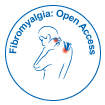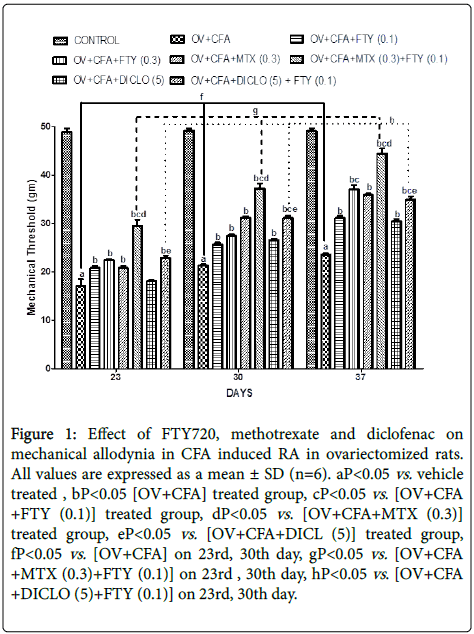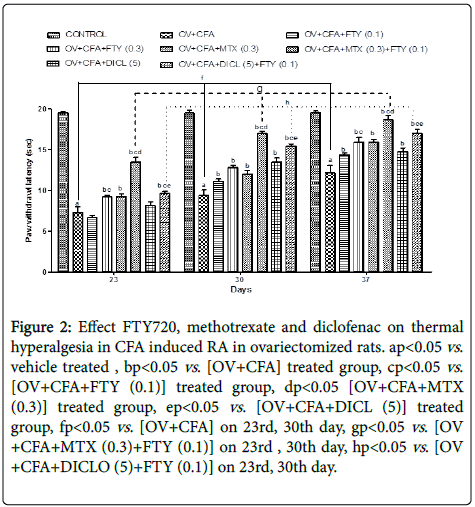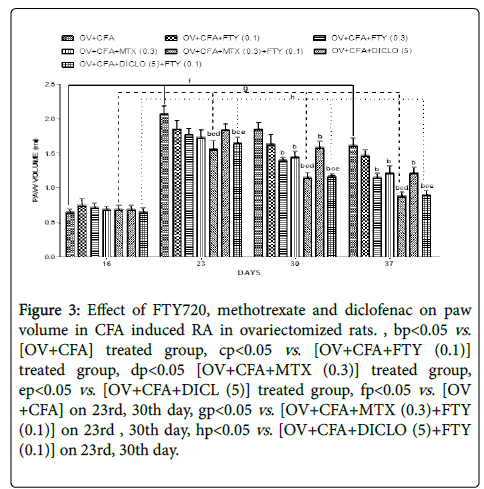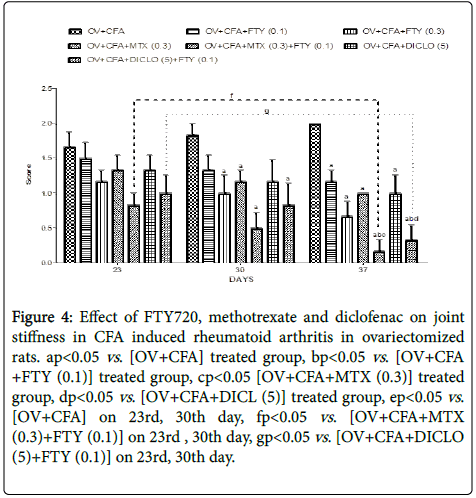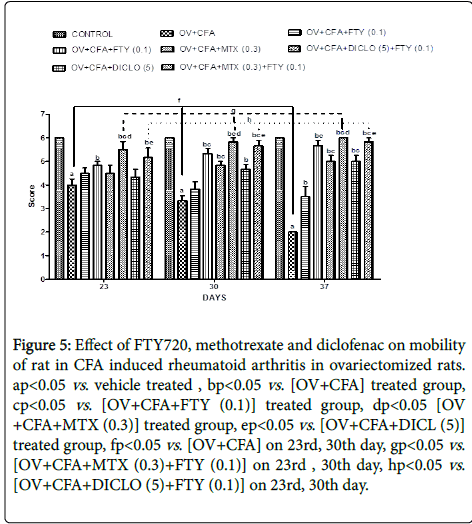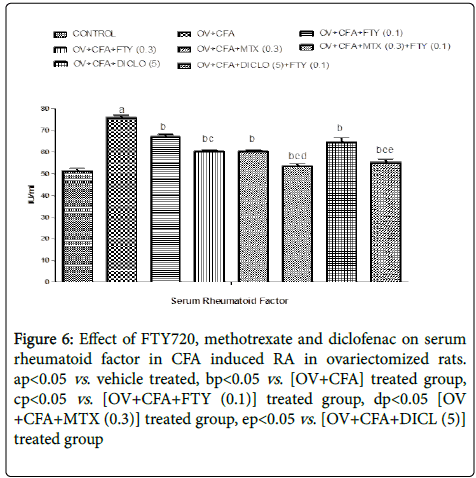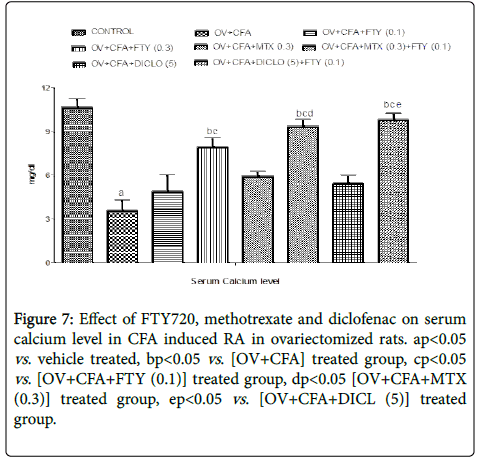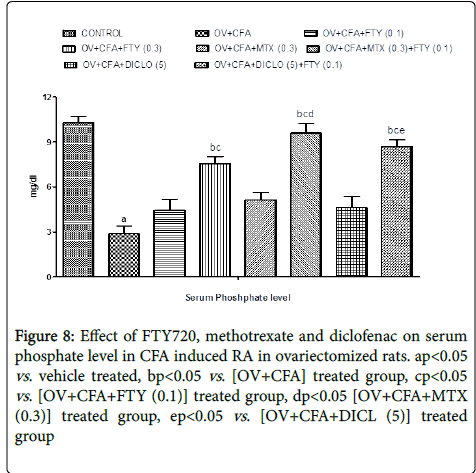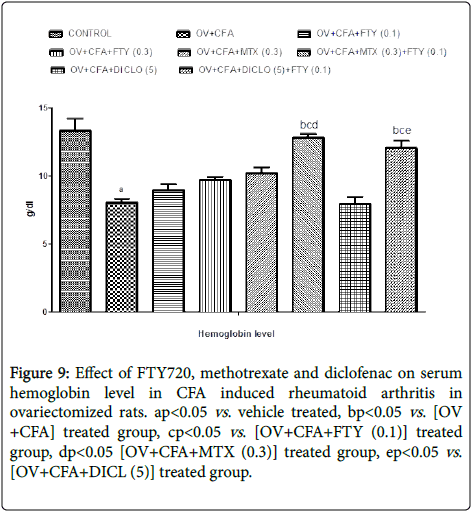Beneficial Effect of Sphingosine-1-Phosphate Receptor Analog as Anti-Arthritic and Anti-Osteoporotic in CFA Induced Ovariectomized Rats
Received: 22-Dec-2016 / Accepted Date: 31-Jan-2017 / Published Date: 06-Feb-2017
Abstract
Objectives: Rheumatoid arthritis (RA) and osteoporosis are chronic diseases characterized by fibroblastic proliferation, infiltration of the synovial lining by inflammatory cells and increase bone resorption respectively. Sphingosine -1-phosphate (S1P) receptor analogues plays unique pathogenic mechanistic role which can be beneficial to reduce the side effects and improve the efficiency for the treatment of rheumatoid arthritis and osteoporosis.
Methods: Osteoporosis and rheumatoid arthritis are induced by ovariectomy and single injection of CFA in rats. On 16th, 23rd, 30th, 37th day after ovariectomy, mechanical allodynia, thermal hyperalgesia, paw volume, joint stiffness and mobility were observed. On 37th day animal sacrificed for rheumatoid factor, calcium and phosphate and haemoglobin count in serum were determined.
Results: Ovariectomy and CFA significantly induced symptoms of osteoporosis and RA in rats like joint stiffness, decrease in mobility, paw oedema, mechanical allodynia and thermal hyperalgesia. Increase in rheumatoid factor and decline of haemoglobin, calcium and phosphate count was also observed after sacrificing the animals. FTY720 (0.1 and 0.3 mg/kg), methotrexate (0.3 mg/kg) and diclofenac (5 mg/kg) attenuated all the behavioural and haematological parameters alone and/or combination as well as alone.
Conclusion: In the present set of experiments FTY720 has shown significant anti-arthritic and anti-osteoporotic effect in rats. Further, when FTY720 low dose was combined with standard drugs like methotrexate and diclofenac showed the synergistic effect.
Keywords: Complete freund’s adjuvant; FTY720; Osteoporosis; Ovariectomy; Rheumatoid arthritis
4703Introduction
Rheumatoid arthritis (RA) and osteoporosis are the joints and bone disorders which are characterized by fibroblastic proliferation, infiltration of the synovial lining by inflammatory cells and increase bone resorption respectively [1]. They ultimately lead to expression of pro-inflammatory cytokines and a paucity of apoptosis resulting in loss in bone mass and joint destruction [2-5]. Demographically, these are the most common diseases that affects approximately 0.5–1.0% of the global population [6].
The main mechanistic involvement in these major bone and joint disorders is pain and stiffness, synovial hyperplasia, massive cellular infiltrations, erosion of cartilage and bone, bone mass loss, altered bone micro architecture and an abnormal immune response [2,6]. It is well known that RA is an autoimmune disease in which migration of CD4 T cells and B lymphocytes from the peripheral blood into the rheumatoid pannus and synovium lead to the release of proinflammatory cytokines and mediators are the main mechanism holder for the disease. On the other hand, osteoporosis mainly involves reduced level of estrogen which cause imbalance in the remodeling cycle of bone i.e. increased osteoclasts formation (bone resorption) and decreased the osteoblasts (bone formation) [5-9]. Diseases must be treated in the early stages because if it is left untreated, it leads to irreversible joint damage and deformity, synovial hypertrophy, pannus formation, increase in fracture risk, premature mortality and ultimately severe disability [3,4]. Various pathways have been evolved and so many are under research for the effective therapy.
Sphingosine-1-phosphate (S1P) receptor is the recent target for exploring the advanced and beneficial therapy of both diseases. As it is cell derived it has diverse cellular signal functions. Sphingomyelin is the main metabolite for the generations of S1P which are further its levels are synchronized by enzymes sphingosine kinase (SK) and S1P phosphatase. S1P acts by binding to GPCR as an extracellular mediator and regulates the cell proliferation, angiogenesis and inflammation.S1P receptors are exclusively released in plasma through platelets upon activation of other cell types, such as erythrocytes, neutrophills, and mononuclear cells.
A very potent modulator of S1P having immunosuppressive activity is FTY720. It is a kind of vegetative wasp that is an “eternal youth” nostrum in traditional Chinese herbal medicine [10,11]. FTY720 also known as fingolimod is a first in class S1P receptor modulator and FDA approved for Multiple Sclerosis [12-14]. The main mechanism of FTY720 is as immunosuppressant by inhibiting the T cell and B cell circulation and blocking their emigration from thymus and lymph nodes into peripheral blood.
Based on previous reports our aim in the present study is to explore the pathogenic role of S1P modulator (FTY720) on CFA induced RA like symptoms in ovariectomized rats to induce osteoporosis. Use of this potent drug as adjuvant with methotrexate and diclofenac an already approved standard drugs for the effective treatment of both diseases with synergistic effects free of side effects of the standard drugs. And also conclude that S1P signaling may play an important role in the RA and osteoporosis.
Material And Methods
Animals and ethics
The experiments were carried out on female Wistar rats (150-250 gm), obtained from central animal house of ISF College of Pharmacy, Moga, Punjab (India). The animals were kept in polyacrylic cages and maintained under standard housing conditions (room temperature 22 ± 20ºC and relative humidity of 60-65%) with 12h light/dark reverse cycle. The food in the form of dry pallets and water were made available ad libitum. The protocol was reviewed and approved by the ‘Institutional Animal Ethics Committee’ and the animal experiments were carried out in accordance with the Indian National Science Academy Guidelines for use and care of animals.
Induction of osteoporosis and RA
Ovariectomy is done on female rats to induce osteoporosis. There is reduction in the level of estrogen in the body after exteriorization of ovaries and the oviduct. On the other hand, CFA (consists of heat killed Mycobacterium butyricum in mineral oil) is used to for the induction of RA.
Experimental procedure
On day 0, ovariectomy of the female rats was conducted to induce osteoporosis in rats. The ovary and the oviduct were exteriorized. After that animals are kept under water and normal diet for 2 weeks before start giving the single administration of CFA to induce RA. On 16th day after ovariectomy, CFA was administered intra-dermally in the hind paw. FTY720 (0.1 and 0.3 mg/kg) doses were given in different groups. Simultaneously the methotrexate (0.3 mg/kg) and diclofenac (5 mg/kg) were administered and combination of these two drugs with FTY720 (0.1 mg/kg) was also given to different groups. On 16th, 23rd, 30th and 37th day the behavioral parameters like mechanical allodynia, thermal hyperalgesia, paw volume, mobility, and joint stiffness were accessed. Then the animals were sacrificed on 37th day for conducting hematologic parameters like hemoglobin, rheumatoid factor, calcium, phosphate levels.
Experimental grouping
Forty two female rats, were randomly divided into eight groups of n=6 rats in each group. Group 1 vehicle treated, group 2 ovariectomized and CFA induced animals, group 3 and 4 animals are ovariectomized and CFA treated with FTY720 (0.1 and 0.3 mg/kg) respectively, group 5 and 6 are ovariectomized and CFA methotrexate (0.3 mg/kg) and in combination with FTY720 (0.1 mg/kg) respectively, while group 7 are ovariectomized and CFA induced diclofenac (5 mg/ kg),in group 8 ovariectomy and CFA with treatment with diclofenac (5 mg/kg) and FTY720 (0.1 mg/kg).
Assessment of CFA induced rheumatoid arthritis in ovariectomized rats
Mechanical allodynia (Von Frey test): The mechanical threshold for touch sensitivity was measured in hind paw, using an automated apparatus for applying device consisting of a steel rod against the plantar region of the paw by increasing force until the animal withdraw its paw. It is done using Dynamic plantar Aesthesiometer 37400-002; Ugo Basile, Comerio, Italy. The maximum force was set at 50 gm prevent tissue damage, and the ramp speed was 0.5 g/s with cut-off is set to 20 seconds. The paw withdrawn latency is checked [15,16].
Thermal Hyperalgesia: Hyperalgesia to thermal stimulation was determined using a Plantar Test Apparatus (37370-002 UgoBasile, Comerio, Italy) modelled as described by Hargreaves et al. Rats were placed individually in Plexiglas cubicles mounted on a glass surface maintained at 25 ± 2C. A thermal stimulus, in the form of radiant heat emitted from a focused projection bulb, which was located under the glass floor, was focused onto the plantar surface of the right hind paw, and paw withdrawal latencies (PWLs) were recorded. A cut-off latency of 20s was imposed to avoid tissue damage [17].
Hind paw volume: The rat hind paw edema, up to the ankle joint, was recorded on day 16, and at pre decided days for the CFA-treated group for the 21 day observation period. The paw volume in the treatment groups was recorded on day 16th, 23rd, 30th and 37st days after the administration of CFA in ovariectomized rats and the drugs were administered from day 16 to day 37. Measurement of left hind paw was taken so as to obtain the absolute increase in paw volume by using mercury plethysmogram (INCO, Ambala, India) [2,18].
Joint stiffness: The scoring of joint stiffness was performed as follows. The body of rats was held from the back with the left palm, and the bending and extension (once in each direction) of the ankle within its limits of range of motion were performed with the right fingers. It was confirmed beforehand that there was no restriction of ankle joint movement in the bending and extension manipulations in naive rats, and the scoring was performed according to the reported evaluation scale: Score 2, there were restrictions of full range of movement of the ankle in both bending and extension; Score 1, there was a restriction of full range of movement of the ankle in bending or extension; Score 0, no restriction. The measurements for joint stiffness were conducted for both hind paws [19].
Measurement of mobility: The scoring of mobility was performed by modifying the evaluation scale reported: Score 6, walks normally; Score 5, walks being protective toward the hind paw (touches the hind paw fully on the floor); score 4, walks being protective toward the hind paw (touches only the toe of the hind paw on the floor); Score 3, walks being protective toward both hind paws (touches the contralateral hind paw fully on the floor); Score 2, walks being protective toward both hind paws (touches only the toe of the contralateral hind paw on the floor); Score 1, crawls only using the fore paws; and Score 0, does not move [19].
Hematological studies
Serum rheumatoid factor (RF): RF was on the 37th day by collecting the blood from the retro orbital route using direct slide agglutation assay [2,20].
Serum calcium and phosphate level: Calcium and phosphate are the main bone density parameters for the diagnosis of osteoporosis assessed on the 37th day in serum using Ortho–Cresolphthalein Complexone (OCPC) method of Moorehead and Briggs, End Point and phosphate diagnostic reagent kit respectively [21].
Hemoglobin level: The level of hemoglobin (Hb) also decreases during the progression of disease as RA causes anemia assessed on the 37th day by in serum using cyan methhemoglobin method [2,20].
Statistical analysis
The data were expressed as Mean ± Standard Error Mean (SEM). The statistical significance of the differences between parameters among the eight experimental groups was evaluated by means of two way and one way analysis of variance. Significant differences among means were identified by Bonferroni post hoc test. The results are given in the text as probability values (P). p<0.05 was adopted as a criterion of significance. Statistical analysis was performed by means of Graph PAD prism Software programs (Version 5.0).
Results
Effect of FTY720, methotrexate and diclofenac on mechanical allodynia and thermal hypersensitivity in CFA induced RA in ovariectomized rats
Ovariectomy of the female rats was conducted to induce osteoporosis. On 16th day the single administration of CFA (0.1 ml) was given intra dermally to induce RA. Further, FTY720 (0.1 and 0.3 mg/kg p.o.), methotrexate (0.3 mg/kg i.p.), diclofenac (5 mg/kg p.o.) were administered simultaneously starting from 16th day and continued up to 37th day (21 day treatment) (Figure 1).
Figure 1: Effect of FTY720, methotrexate and diclofenac on mechanical allodynia in CFA induced RA in ovariectomized rats. All values are expressed as a mean ± SD (n=6). aP<0.05 vs. vehicle treated , bP<0.05 [OV+CFA] treated group, cP<0.05 vs . [OV+CFA +FTY (0.1)] treated group, dP<0.05 vs . [OV+CFA+MTX (0.3)] treated group, eP<0.05 vs. [OV+CFA+DICL (5)] treated group, fP<0.05 vs. [OV+CFA] on 23rd, 30th day, gP<0.05 vs. [OV+CFA +MTX (0.3)+FTY (0.1)] on 23rd , 30th day, hP<0.05 vs . [OV+CFA +DICLO (5)+FTY (0.1)] on 23rd, 30th day.
There was significant decrease seen in pain threshold and thermal hypersensitivity in CFA treated group as measured on 23rd, 30th, 37th day as compared to vehicle treated group. Pretreatment with FTY720 (0.1 and 0.3 mg/kg), methotrexate (0.3 mg/kg) and diclofenac (5 mg/kg) significantly increased the mechanical threshold and thermal hyperalgesia as compared to the CFA treated group. However, low dose of FTY720 (0.1 mg/kg) in combination with methotrexate (0.3 mg/kg) and diclofenac (5 mg/kg) potentiated their protective effects as compared to their effect alone (Figure 2).
Figure 2: Effect FTY720, methotrexate and diclofenac on thermal hyperalgesia in CFA induced RA in ovariectomized rats. ap<0.05 vs . vehicle treated , bp<0.05 vs . [OV+CFA] treated group, cp<0.05 vs . [OV+CFA+FTY (0.1)] treated group, dp<0.05 [OV+CFA+MTX (0.3)] treated group, ep<0.05 vs . [OV+CFA+DICL (5)] treated group, fp<0.05 vs . [OV+CFA] on 23rd, 30th day, gp<0.05 vs . [OV +CFA+MTX (0.3)+FTY (0.1)] on 23rd , 30th day, hp<0.05 vs . [OV +CFA+DICLO (5)+FTY (0.1)] on 23rd, 30th day.
Effect of FTY720, methotrexate and diclofenac on paw volume in CFA induced RA in ovariectomized rats
CFA (0.1 ml) injection intra-dermally significantly attenuated the paw volume of rats after 7 days of injection i.e. on 23rd day. FTY720 (0.3 mg/kg), methotrexate (0.3 mg/kg) and diclofenac (5mg/kg) significant decreased the paw volume as compared to CFA treated groups. FTY720 (0.1 mg/kg) did not produced any significant effect on paw volume as compared to CFA treated groups. Whereas combination of FTY720 (0.1 mg/kg) with methotrexate (0.3 mg/kg) and diclofenac (5 mg/kg) produced synergistic effect as compared to their effect alone (Figure 3).
Figure 3: Effect of FTY720, methotrexate and diclofenac on paw volume in CFA induced RA in ovariectomized rats. , bp<0.05 vs . [OV+CFA] treated group, cp<0.05 vs . [OV+CFA+FTY (0.1)] treated group, dp<0.05 [OV+CFA+MTX (0.3)] treated group, ep<0.05 vs . [OV+CFA+DICL (5)] treated group, fp<0.05 vs . [OV +CFA] on 23rd, 30th day, gp<0.05 vs . [OV+CFA+MTX (0.3)+FTY (0.1)] on 23rd , 30th day, hp<0.05 vs . [OV+CFA+DICLO (5)+FTY (0.1)] on 23rd, 30th day.
Effect of FTY720, methotrexate and diclofenac on joint stiffness and mobility in CFA induced RA in ovariectomized rats
Administration of CFA (0.1 ml) injection intra-dermally significantly attenuated the joint stiffness score and increased mobility score in rats after 7 days of injection i.e. on 23rd day. FTY720 (0.3 mg/ kg), methotrexate (0.3 mg/kg) and diclofenac (5mg/kg) significant decreased the joint stiffness (decreased in score) and increased mobility score as compared to CFA treated groups (Figure 4).
Figure 4: Effect of FTY720, methotrexate and diclofenac on joint stiffness in CFA induced rheumatoid arthritis in ovariectomized rats. ap<0.05 vs . [OV+CFA] treated group, bp<0.05 vs . [OV+CFA +FTY (0.1)] treated group, cp<0.05 [OV+CFA+MTX (0.3)] treated group, dp<0.05 vs . [OV+CFA+DICL (5)] treated group, ep<0.05 vs . [OV+CFA] on 23rd, 30th day, fp<0.05 vs . [OV+CFA+MTX (0.3)+FTY (0.1)] on 23rd , 30th day, gp<0.05 vs . [OV+CFA+DICLO (5)+FTY (0.1)] on 23rd, 30th day.
FTY720 (0.1 mg/kg) did not produced any significant effect on score for joint stiffness as compared to CFA treated groups. Whereas combination of FTY720 (0.1 mg/kg) with methotrexate (0.3 mg/kg) and diclofenac (5 mg/kg) produced synergistic effect as compared to their effect alone (Figure 5).
Figure 5: Effect of FTY720, methotrexate and diclofenac on mobility of rat in CFA induced rheumatoid arthritis in ovariectomized rats. ap<0.05 vs . vehicle treated , bp<0.05 vs . [OV+CFA] treated group, cp<0.05 vs . [OV+CFA+FTY (0.1)] treated group, dp<0.05 [OV +CFA+MTX (0.3)] treated group, ep<0.05 vs . [OV+CFA+DICL (5)] treated group, fp<0.05 vs . [OV+CFA] on 23rd, 30th day, gp<0.05 vs . [OV+CFA+MTX (0.3)+FTY (0.1)] on 23rd , 30th day, hp<0.05 vs . [OV+CFA+DICLO (5)+FTY (0.1)] on 23rd, 30th day.
Effect of FTY720, methotrexate and diclofenac on serum rheumatoid factor in CFA induced RA in ovariectomized rats
Single administration of CFA (0.1 ml) intra-dermally significantly attenuated the serum rheumatoid factor as compared to normal control group. Further, pretreatment with FTY720 (0.1 and 0.3 mg/kg) a sphignosine-1-phosphate receptor analog significantly decreased the rheumatoid factor in serum as compared to the CFA treated group. Whereas, methotrexate (0.3 mg/kg) and diclofenac (5 mg/kg) being the standard drugs also showed significant decreased rheumatoid factor in serum as compared to the disease control group. Whereas combination of FTY720 (0.1 mg/kg) with methotrexate (0.3 mg/kg) and diclofenac (5 mg/kg) produced synergistic effect as compared to their effect alone (Figure 6).
Figure 6: Effect of FTY720, methotrexate and diclofenac on serum rheumatoid factor in CFA induced RA in ovariectomized rats. ap<0.05 vs . vehicle treated, bp<0.05 vs . [OV+CFA] treated group, cp<0.05 vs . [OV+CFA+FTY (0.1)] treated group, dp<0.05 [OV +CFA+MTX (0.3)] treated group, ep<0.05 vs . [OV+CFA+DICL (5)] treated group
Effect of FTY720, methotrexate and diclofenac on serum calcium and phosphate level in CFA induced RA in ovariectomized rats
Single administration of CFA (0.1 ml) intra-dermally significantly attenuated the serum calcium and phosphate as compared to normal control group. Further, pretreatment with FTY720 (0.3 mg/kg) a sphignosine-1-phosphate receptor analog significantly increased the calcium in serum and phosphate as compared to the CFA treated group (Figure 7). FTY720 (0.1 mg/kg), methotrexate (0.3 mg/kg) and diclofenac (5 mg/kg) alone did not produced appreciable effect. Whereas combination of FTY720 (0.1 mg/kg) with methotrexate (0.3 mg/kg) and diclofenac (5 mg/kg) produced synergistic effect as compared to their effect alone (Figure 8).
Figure 7: Effect of FTY720, methotrexate and diclofenac on serum calcium level in CFA induced RA in ovariectomized rats. ap<0.05 vs . vehicle treated, bp<0.05 vs . [OV+CFA] treated group, cp<0.05 vs . [OV+CFA+FTY (0.1)] treated group, dp<0.05 [OV+CFA+MTX (0.3)] treated group, ep<0.05 vs . [OV+CFA+DICL (5)] treated group.
Figure 8: Effect of FTY720, methotrexate and diclofenac on serum phosphate level in CFA induced RA in ovariectomized rats. ap<0.05 vs . vehicle treated, bp<0.05 vs . [OV+CFA] treated group, cp<0.05 vs . [OV+CFA+FTY (0.1)] treated group, dp<0.05 [OV+CFA+MTX (0.3)] treated group, ep<0.05 vs . [OV+CFA+DICL (5)] treated group
Effect of FTY720, methotrexate and diclofenac on serum hemoglobin level in CFA induced RA in ovariectomized rats
Administration of CFA (0.1 ml) injection intra-dermally significantly attenuated serum hemoglobin level as compared to the CFA induced group. Pretreatment with FTY720 (0.1 and 0.3 mg/kg), methotrexate (0.3 mg/kg) and diclofenac (5 mg/kg) in their alone treated groups did not significantly attenuated the levels as compared to the CFA treated group. Whereas, in combination with low dose of FTY720 (0.1 mg/kg) with methotrexate (0.3 mg/kg) and diclofenac (5 mg/kg) produced significant effects as compared to CFA treated group (Figure 9).
Figure 9: Effect of FTY720, methotrexate and diclofenac on serum hemoglobin level in CFA induced rheumatoid arthritis in ovariectomized rats. ap<0.05 vs . vehicle treated, bp<0.05 vs . [OV +CFA] treated group, cp<0.05 vs . [OV+CFA+FTY (0.1)] treated group, dp<0.05 [OV+CFA+MTX (0.3)] treated group, ep<0.05 vs . [OV+CFA+DICL (5)] treated group.
Discussion
Rheumatoid arthritis (RA) is a chronic, systemic disease that is characterized by synovial hyperplasia, massive cellular infiltrations, erosion of cartilage and bone, and an abnormal immune response [22]. It is an autoimmune disease occurs when autoimmune responses lead to tissue damage [9,23]. Osteoporosis is another disease which is directly or indirectly linked with the joint and bone disorder. Osteoporosis (means porous bones) is the condition in which a low bone mass and altered micro architecture of the bone leads to increased risk of fracture [6]. It mainly occurs in females due to the depletion of estrogen level in the body which ultimately affects the bone mineral density and strength to the extent that fractures can even occur after minimal trauma and hence, causes this severe disease.
The best model for the RA is CFA i.e. complete freund’s adjuvant induced RA [23]. It contains heat killed Mycobacterium butyricum in mineral oil which modulates the expression of the CD16 receptor. This alters pro-inflammatory cytokine release in monocytes/macrophages when auto-antigens and arthritic factors bind the CD16 receptor [17,24]. This induces chondrocyte death in the articular cartilage of rodent and non-rodent species. Thus there is impaired vasculature, increase in vascular oxidative stress and increased production of vascular ROS which causes the arthritis. Maximum effect of CFA is seen in 7 days [24].
Ovariectomy is the main model to induce osteoporosis. Due to ovariectomy there is sex hormone deficiency in animal which leads to decrease in bone thickness, bone mineral density, bone hardness and strength to the extent that fractures can even occur after minimal trauma [23]. Both diseases share many similar characteristics. These include increased rate of bone turnover with resorption exceeding formation and initial rapid phase of bone loss followed by a much slower phase and decreased intestinal absorption of calcium and phosphate [25]. It is well proved in the previous studies that in human females, estrogen deficiency caused by ovariectomy as well as menopause leads to acceleration of bone resorption and rapid bone loss, resulting in development of osteoporosis [26,27].
In present study we successfully explored the beneficial effect of FTY720 (S1P analog) against animal model of CFA and ovariectomized induced RA and osteoporosis in rats. We hypothesized that anti-inflammatory and immunosuppressive mechanisms are involved in the protective effect of FTY720. Further, it is hypothesized that FTY720 enhance the immunosuppressive effect of methotrexate in additional anti-inflammatory effect. In present research the RA was induced in ovariectomized rats. So, that symptom of the diseases, RA and osteoporosis appear simultaneously in rodents. Further, both the diseases lead to produce various pathological changes like synovial membrane inflammation, joint swelling, stiffness in joint and decrease in mobility. There is also decrease in mechanical allodynia and thermal hyperalgesia, hemoglobin and increase in rheumatoid factor which are related to the CFA induced arthritis while the decrease in calcium and phosphate levels are related to the ovariectomy induced osteoporosis [9,21]. The determination of mechanical allodynia, thermal hyperalgesia, and paw volume (swelling) is apparently simple, sensitive, and quick procedure for evaluating the degree of inflammation and assessing therapeutic effects of drugs. T-cell proliferation is an important mechanism to cause disease; specifically their differentiation into Th-1 helper cells. Therefore, due to increase in paw edema is the main effect of Th-1 helper cells. The progression of arthritis is characterized by increase of the paw footpad and tibiotarsal joint diameters [2]. Decrease in mobility and stiffness in joints is cause of both RA and osteoporosis. Increase in pro-inflammatory cytokines, depletion of synovial fluid, over expression and overproduction of TNF, arising from interactions between T and B cells cause loss of lubrication between the joints and thus detoriation and deformity of bones start. Animal feels pain while movement [21].
Rheumatoid factor (RF) is the main autoantibody which is fo rmed during the RA. It has been set as a hallmark for the disease. RF generation in arthritis involves B cell activation via toll-like receptors and several genetic predispositions to arthritic diseases. Further, it allows the activation of inflammatory mediators to cause bone deformity and joint destruction [2,20]. The level of hemoglobin (Hb) also decreases during the progression of disease as RA causes anemia. Hb count during arthritis results from reduced erythropoietin levels, a decreased response of the bone marrow erythropoietin and premature destruction of red blood cells [20]. Calcium and phosphate are the main bone density parameters for the diagnosis of osteoporosis. Decrease in calcium and phosphate absorption in serum of ovariectomized animals is due to decline of estrogen level. The main cause of it is due to alteration in the osteoclastic and osteoblastic activity which decreases the bone mineral density [21].
FTY720 pretreatment significantly reversed the symptoms of both diseases induced by CFA injected in ovariectomized rats. Further, sub effective dose of FTY720 with diclofenac and methotrexate synergize their protective effect showed beneficial effect of FTY720 in both the diseases. Methotrexate alone showed the significant effect because it is a potent immunosuppressant while diclofenac does not showed significant effect as compared with methotrexate because diclofenac is an analgesic. When the low dose of FTY720 was combined with methotrexate it showed synergistic results as with diclofenac. So, it can be hypothesize that methotrexate and FTY720 working by interrelated mechanism.
FTY720 is a S1P receptor analog. These S1P receptors are more highly expressed in synovial lining cells, vascular endothelial cells, and inflammatory mononuclear cells of RA synovium. Drug suppresses the disease via suppressing synovial hyperplasia and lymphocyte infiltration. It has potential chondro protective effect together with its immunosuppressive effect [28]. FTY720 is the phosphorylated form of S1P. Phosphorylated FTY is formed after the internalization of FTY720 with the S1P receptor which actually has the immunosuppressive and has role in altering the osteoclastic and osteoblastic activity. It balances the bone resorption and bone formation [29]. Secondly, phosphorylated FTY720 binds with high affinity to S1P1 expressed on lymphocytes [30].
Further, this whole mechanism involves S1P which enhances inflammatory cytokine (TNF-α or IL-1β) induced COX-2 expression and PGE2 production in the synovium of RA. RANKL (receptor activate nuclear factor kappa ligand) is expressed by synovial fibroblasts and activated T cells from RA tissues [30-39]. Furthermore, extracellular S1P enhanced RANKL expression in activated T cells. Therefore, S1P produced under inflammatory conditions, helps to treat the disease by down regulation pathway. This down regulation renders lymphocytes unresponsive to the normal S1P gradient and thus deprives them of the obligatory signal that would ordinarily allow them to ergs from lymphoid tissues and recirculation to the periphery. Oral dose of drug thus prevents normal egress of lymphocytes, including auto aggressive forms, which are retained in lymph organs and away from sites of inflammation [30]. Thus, treats the both diseases simultaneously.
As it is proved in the given mechanism that T cells and B lymphocytes proliferation is the main cause of pain threshold paw edema, joint stiffness and decrease in mobility. FTY20 is used to treat these symptoms as its main mechanism involves the blockage of T cells and B cells from circulating in the blood. Due to this it is used to reduce the RF and normal the hemoglobin levels [31].
As FTY720 is helpful in balancing the bone resorption and bone formation which are further responsible for the bone mineral density. S1P has multiple functions in osteoclasts, including stimulating their motility, providing dynamic control over the migration of osteoclasts precursors, and maintaining bone mineral density and increased osteoclastogenesis [38]. In addition it stimulates osteoblasts migration and promotes their survival at sites of bone resorption which is important for osteogenesis. Osteoclasts might recruit osteoprogenitors (OPG) cells to the site of bone remodeling through the SIP and stimulate bone formation through increased activation of Wnt/BMP pathways [37,39]. This prevents S1P receptor-induced migration of these bone resorbing cells away from bone. FTY720 prevented bone loss by decreasing osteoclasts attachment to bone and increasing osteoblasts attachment which are bone forming cells. Hence, it leads to normalize the calcium and phosphate levels in the body [32,40].
Conclusion
In the conclusion, FTY720 has showed significant anti-arthritic and anti-osteoporotic effect in rats. Further studies are needed for clinical implication of FTY720 as new RA and osteoporosis medicine.
Conflict of Interest
Authors has no conflict of interest
References
- Jochems C, Lagerquist M, HÃ¥kansson C, Ohlsson C, Carlsten H (2008) Long-term anti-arthritic and anti-osteoporotic effects of raloxifene in established experimental postmenopausal polyarthritis. ClinExpImmunol 152(3):593-597.
- Patel SS, Shah PV(2013) Evaluation of anti-inflammatory potential of the multidrug herbomineral formulation in male Wistar rats against rheumatoid arthritis. J Ayurveda Integr Med. 4(2): 86-93.
- Ndosi M, Lewis M, Hale C, Quinn H, Ryan S et al.(2013) The outcome and cost-effectiveness of nurse-led care in people with rheumatoid arthritis: a multicentrerandomised controlled trial. Ann Rheum Dis 73:1975-1982
- Tanaka Y, Yamaoka K(2013) JAK inhibitor tofacitinib for treating rheumatoid arthritis: from basic to clinical. Mod Rheumatol. 23(3):415-424.
- Raisz LG (2005) Pathogenesis of osteoporosis: concepts, conflicts, and prospects. J Clin Invest 115(12):3318-3325.
- Gu Q, Cai Y, Huang C, Shi Q, Yang H(2012)Curcumin increases rat mesenchymal stem cell osteoblast differentiation but inhibits adipocyte differentiation. Pharmacogn Mag 8(31): 202–208.
- Zerbini CA, McClung MR (2013)Odanacatib in postmenopausal women with low bone mineral density: a review of current clinical evidence. TherAdvMusculoskelet Dis 5(4):199-209.
- McClung M, Harris ST, Miller PD, Bauer DC, Davison KS et al. (2013) Bisphosphonate therapy for osteoporosis: benefits, risks, and drug holiday. Am J Med 126(1):13-20.
- Chen L, BaoB, Wang N, Xie J and Wu W(2012) Oral administration of shark type ii collagen suppresses complete freund’s adjuvant-induced rheumatoid arthritis in rats. Pharmaceuticals 5(3):339-352.
- Chiba K, Matsuyuki H, Maeda Y, Sugahara K (2006) Role of Sphingosine 1-Phosphate Receptor Type 1 in Lymphocyte Egress from Secondary Lymphoid Tissues and Thymus. Cell MolImmunol 3(1):11-19.
- Adachi K, Chiba K(2007) FTY720 Story. Its Discovery and the Following Accelerated Development of Sphingosine 1-Phosphate Receptor Agonists as Immunomodulators Based on Reverse Pharmacology. PerspectMedicinChem1:11-23.
- Yoshida Y, Tsuji T, Watanabe S, Matsushima A, Matsushima Y et al.(2013) Efficacy of Combination Treatment with Fingolimod (FTY720) Plus Pathogenic Autoantigen in a Glucose-6-phosphate Isomerase Peptide (GPI 325–339)-Induced Arthritis Mouse Model. Biol Pharm Bull 36(11):1739-1746.
- Graler MH(2012) The role of sphingosine 1-phosphate in immunity and sepsis. Am J ClinExpImmunol1(2):90-100.
- Tsunemi S, Iwasaki T, Miyazawa K, Kitano S, Kanda C et al.( 2011)Therapy of autoimmune diseases by novel immunosuppressant FTY720. Inflam and Reg2(3):11-19.
- Themistocleous A, Kamerman P, Mitchell D (2007) Pre-emptive ring-block with bupivacaine prevents the development of thermal hyperalgesia, but not sustained mechanical hyperalgesia, in rat tails exposed to ultraviolet A light. J Pain 8(3):208-214.
- Möser CV, Kynast K, Baatz K, Russe OQ, Ferreirós N et al. ( 2011)HyperalgesiaTarget for the Treatment of Inflammatory Is a Potential ε The Protein Kinase IKK. J Immunol187(5):2617-2625.
- Song MJ, Wang YQ, Wu GC (2009) Additive anti-hyperalgesia of electroacupuncture and intrathecal antisense oligodeoxynucleotide to interleukin-1 receptor type I on carrageenan-induced inflammatory pain in rats. Brain Res Bull 78(6):335-341.
- Loyd DR, Chen PB, Hargreaves KM (2012) Anti-hyperalgesic effects of anti-serotonergic compounds on serotonin- and capsaicin-evoked thermal hyperalgesiain the rat. Neuroscience 203:207-215.
- Nagakura Y, Okada M, Kohara A, Kiso T, Toya T et al.( 2003) Allodynia and hyperalgesia in adjuvant-induced arthritic rats: time course of progression and efficacy of analgesics. J PharmacolExpTher306(2):490-497.
- Mikolajew M, Kuratowska Z, Kossakowska M, Plachecka M, KopeC M (1969)Haematological changes in adjuvant disease in the rat. I. peripheral blood and bone marrow after repeated injections of freund's adjuvant. Ann Rheum Dis 28(1):35-40.
- Chitme HR, Muchandi IS and Burl SC (2009) Effect of asparagus racemosuswilld root extract on ovariectomized rats. The Open Natural Products Journal 2: 16-23.
- Fitzpatrick LR, Green C, Frauenhoffer EE,French KJ,Zhuang Yet al. (2011)Attenuation of arthritis in rodents by a novel orally-available inhibitor of sphingosine kinase. Inflammopharmacology. 201; 19(2):75-87
- Zhao W, Tong T, Wang L, Li PP, Chang Y et al. (2011) Chicken type II collagen induced immune tolerance of mesenteric lymph node lymphocytes by enhancing beta2-adrenergic receptor desensitization in rats with collagen-induced arthritis. Int. Immunopharmacol11(4):12-18
- Abudoleh S, Disi A,Qunaibi E and Aburjai T (2011) Anti-arthritic activity of the methanolic leaf extract of urticapiluliferal on albino rats 6(1): 27-32.
- Parisuthiman D, Singhatanadgit W, Dechatiwongse T, KoontongkaewS (2009)Cissusquadrangularis extract enhances biomineralization through up-regulation of MAPK-dependent alkaline phosphatase activity in osteoblasts. Cell DevBiolAnim45(3):194-200.
- Dontas IA and Yiannakopoulos CK (2007) Risk factors and prevention of osteoporosis-related fractures. J Musculoskeletal Neuronal Interact7(3):268-272.
- Aswar U M, Mohan V andBodhankar S L (2012) Anti-osteoporotic activity of phytoestrogen-rich fraction separated from ethanol extract of aerial parts of Cissusquadrangularis in ovariectomized rats. Indian J Pharmacol44(3):345-350.
- Brinkmann V, Billich A, Baumruker T, Heining P, Schmouder R (2010) Fingolimod (FTY720): discovery and development of an oral drug to treat multiple sclerosis. Nat Rev Drug Discov9(11):883-897.
- Sato C, Iwasaki T, Kitano S, Tsunemi S, Sano H (2012)Sphingosine 1-phosphate receptor activation enhances BMP-2-induced osteoblast differentiation. BiochemBiophys Res Commun. 423(1):200-205.
- Bedia C, Levade T, Codogno P (2011) Regulation of autophagy by sphingolipids. Anticancer Agents Med Chem11(9):844-853.
- Takabe K, Steven W. Paugh, Milstein M, Spiegel S (2008)“Inside-Out†signaling of sphingosine-1-phosphate: therapeutic targets. Pharmacol Rev 60 (3):181–195
- Jin Y, Zollinger M, Borell H, Zimmerlin A. Patten C.J (2011)CYP4F enzymes are responsible for the elimination of fingolimod (fty720), a novel treatment of relapsing multiple sclerosis. Drug MetabDispos 39(2):191-198.
- Cherilyn R. Strader, Cedric J. Pearce, and Nicholas H Oberlies (2011)Fingolimod (FTY720): A recently approved multiple sclerosis drug based on a fungal secondary metabolite. J Nat Prod 74(4):900-907.
- Bijjem KR, Padi SS, Sharma PL (2013) Pharmacological activation of hemeoxygenase (HO)-1/carbon monoxide pathway prevents the development of peripheral neuropathic pain in Wistar rats. NaunynSchmiedebergs Arch Pharmacol386(1):79-90.
- Pi X, Tan SY, Hayes M, Xiao L, Shayman JA et al. (2006)Sphingosine kinase 1-mediated inhibition of Fas death signaling in rheumatoid arthritis B lymphoblastoid cells. Arthritis Rheum54(3):754-764.
- Takeshita H, Kitano M, Iwasaki T, Kitano S, Tsunemi S et al. (2012) Sphingosine 1-phosphate (S1P)/S1P receptor 1 signaling regulates receptor activator of NF-κB ligand (RANKL) expression in rheumatoid arthritis. BiochemBiophys Res Commun419(2):154-159
- Kitano M, Hla T, Sekiguchi M, Kawahito Y, Yoshimura R et al. (2006)Sphingosine 1-phosphate/sphingosine 1-phosphate receptor 1 signaling in rheumatoid synovium: regulation of synovial proliferation and inflammatory gene expression. Arthritis Rheum 54(3):742-753.
- Maceyka M, Harikumar KB, Milstien S, Spiegel S (2012) Sphingosine-1-phosphate signaling and its role in disease. Trends Cell Biol22(1): 50-60.
- Ryu J, Kim HJ, Chang EJ, Huang H, Banno Y et al. (2006) Sphingosine 1-phosphate as a regulator of osteoclast differentiation and osteoclast-osteoblast coupling. EMBO J 25(24):5840-5851.
- Rosen H, Gonzalez-Cabrera PJ, Sanna MG, Brown S (2009)Sphingosine 1-phosphate receptor signaling. Annu Rev Biochem78:743-768.
Citation: Shilpi S, Krishna Reddy V, Kumar BP (2017) Beneficial Effect of Sphingosine-1-Phosphate Receptor Analog as Anti-Arthritic and Anti-Osteoporotic in CFA Induced Ovariectomized Rats. Fibrom Open Access 2: 114.
Copyright: © 2017, Shilpi S, et al. This is an open-access article distributed under the terms of the Creative Commons Attribution License, which permits unrestricted use, distribution, and reproduction in any medium, provided the original author and source are credited.
Select your language of interest to view the total content in your interested language
Share This Article
Open Access Journals
Article Usage
- Total views: 3740
- [From(publication date): 0-2017 - Jul 01, 2025]
- Breakdown by view type
- HTML page views: 2856
- PDF downloads: 884
